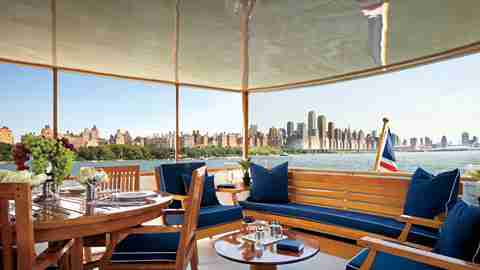Mitchell Turnbough
View Slideshow

Some projects begin with inspiration—and some begin with desperation. Mitchell Turnbough's plan for a new residence was a project of the latter kind. "To all intents and purposes I was homeless," says the designer, who at the time was an associate partner with Bray-Schaible in New York. "The building I'd been renting in got sold, and I had to move." In a scenario familiar to anyone who has recently scanned the pages of a newspaper real estate section, he could find nothing he liked in the city at a price he wanted to pay. But then his mother, of all people, came up with an idea. Turnbough had grown up on the Gulf Coast, in Biloxi, Mississippi, and had been messing about in friends' boats for years; why didn't he get a boat, his mother asked—a boat big enough to live on?
At first this seemed a counterintuitive suggestion. After all, everyone knows J. P. Morgan's famous response to the question of how much a yacht costs: "If you have to ask, don't buy one!" But a friend of Turnbough's—on whose 127-footer he had often served as crew—had another piece of advice: "Don't keep track of what you spend, and you'll be fine." And, fortunately, the young woman Turnbough had been seeing was intrigued by the idea of living on the water. So Turnbough went online to scout prospects and almost immediately found himself irresistibly drawn to a 67-foot wood yacht manufactured in 1965 at the fabled Annapolis boatyard of John Trumpy Sons, builders of the presidential yacht Sequoia . Sleek, svelte, with glossy teak accentuating its horizontal lines, it had been originally named Odyssey and was later renamed Paragon —and it turned out to have endured almost as many trials as Homer's hero did.
For, as Turnbough discovered after traveling to Florida to inspect it, Paragon 's clean original lines had been obscured by "layers and layers of Floridian cheap-condo stuff"—wallpaper, wall-to-wall carpeting and the like. Far from being discouraged, however, Turnbough was enamored—and he bought the boat on the spot. Sailing back to New York up the Intracoastal Waterway, he spent as much time doing demolition as navigating. "When I wasn't steering, I was pulling up carpet," he recalls.
After finding anchorage in the Newport, New Jersey, marina opposite Tribeca, Turnbough proceeded to furnish and outfit his new home. "I wanted to get back to the original of the boat, to make it look the way it did in 1965," he says. He removed layers of paint from teak and mahogany cabinetry, stripped and replated hardware, relaid cork flooring and replaced scratched cabinet tops with plastic laminate "because that was the material they used in 1965."
He brought almost nothing with him from his previous, land-based life: only some vintage silver, photographs and a square ottoman that fit nicely into the above-deck forward lounge. His furniture and fixture purchases, however, look as if they've been aboard from the day the boat left the shipyard. In the deck lounge, he built streamlined wood bookcases to complement the original cabinetry, and in the wheelhouse, he created a design work space by installing a collapsible teak drafting table for the aft wall that seems a partner to the boat's mahogany chart file and steering bench. And for the aft deck, which serves as a dining and lounging area, he found a teak dining table and chairs, as well as a vintage Danish low table, that might have been lifted from a yacht in one of the early James Bond films. The art—vintage black-and-white photographs and a French cruise-ship advertising lithograph from 1954—reinforces the mid-century vibe.
Boats impose special requirements on those who live in them: no wasted space, no excess baggage, maximum efficiency everywhere. So for the master stateroom, Turnbough designed recessed bookcases into the cabin walls to conserve space and provided streamlined seating by running banquettes beneath them. In the lounge and wheelhouse and on deck, chairs and banquettes are upholstered in fade-proof, stain-resistant material that can withstand the effects of salt air and water.
On New Year's Eve of 2000, although he was in the middle of restoration—"I don't think I'll ever be finished," he says—Turnbough threw a party for 50 people on board the boat. "To be out there on the water, with the fireworks over the Statue of Liberty, was just magical," he remembers. An even more magical moment came when he and Jennifer Bilanski, the agreeable young woman who had encouraged him to buy Paragon in the first place, sailed the boat to Martha's Vineyard and were married in a ceremony on the aft deck. The pair now have a toddler daughter, Violet Lula, and are expecting their second child in September. Asked how they manage in the constrained space of even a 67-foot yacht, Turnbough laughs. "The previous owner had three children!" he says.
Paragon became more than a home to Turnbough in 2003, when the Bray-Schaible firm dissolved and he set up his own design office on board. "It's a wonderful place to work," he says. "I love being able to experience Manhattan as an island, something you never think of when you're in the middle of it." There are other benefits, too. "When the weather's nice and we want to go for a swim, we just cast off and sail upriver to the Palisades." How many people can say that about their home and office?